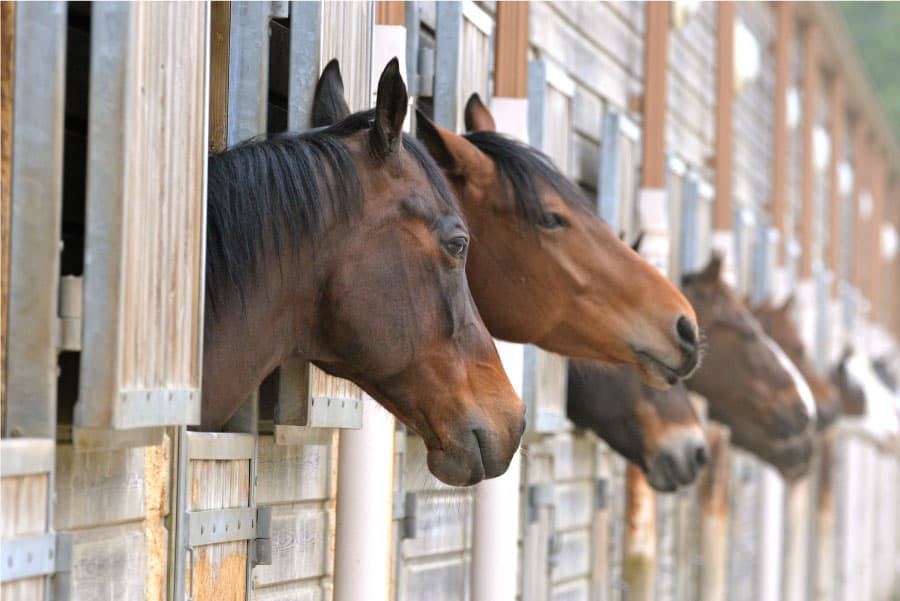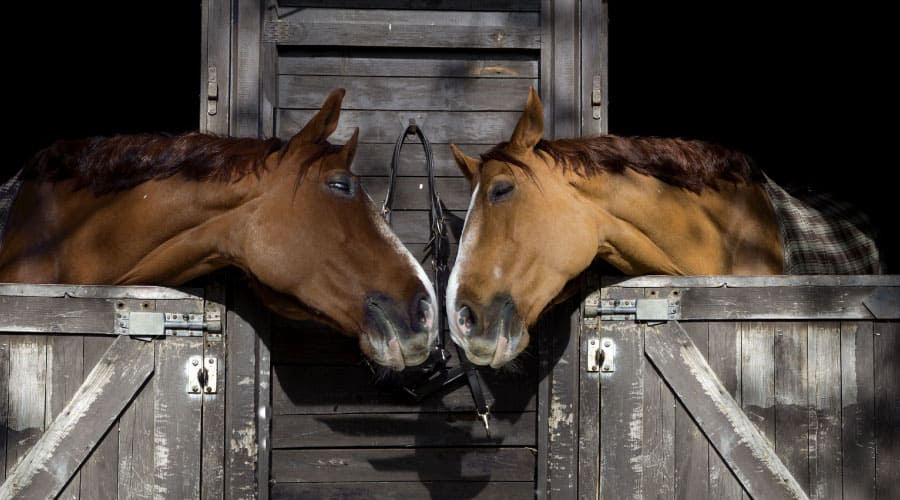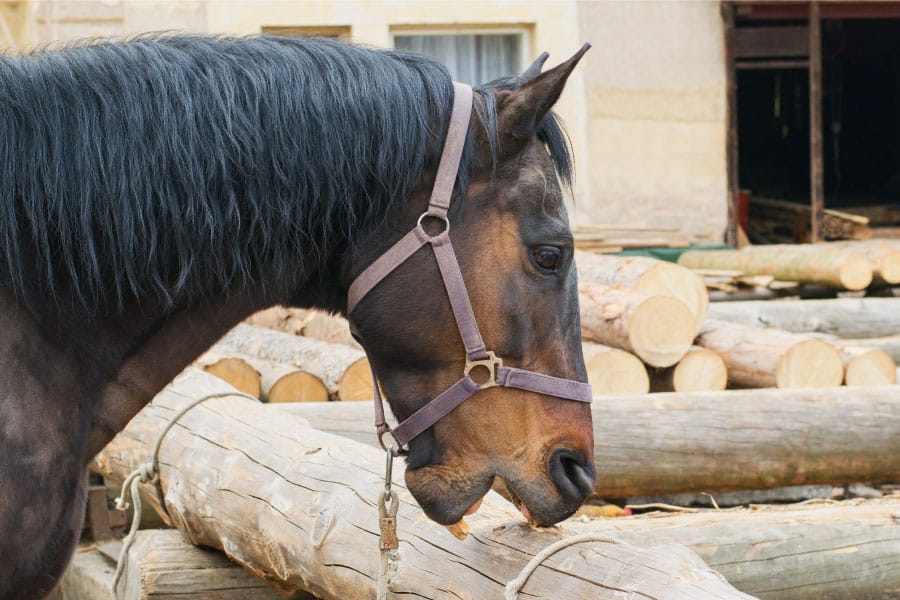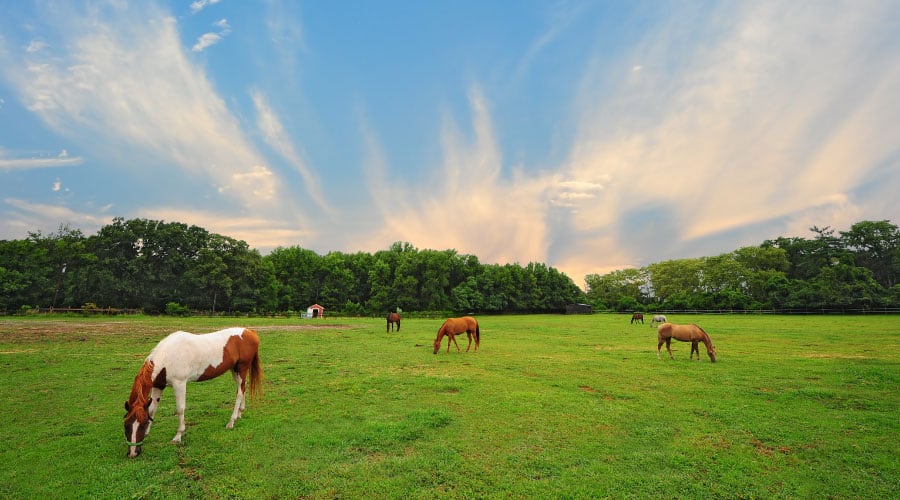- Your source for stall mats, rubber arena footing, arena harrows and arena dust control.

Ever wondered if your horse is happy in a stable? Are you perhaps trying to decide whether to keep your horse stabled or pastured ? Are you not sure why your horse is displaying strange behavior in the stable?
? Are you not sure why your horse is displaying strange behavior in the stable?
Most horses would prefer to be outside and not in stables, however, that does not necessarily mean that they are unhappy in stables. When it comes to stabled horses, social interaction, grazing, and movement are restricted but they are also less likely to get injured and sick compared to being pastured full time. Horses that are unhappy in stables also display behavior issues such as box walking, wind-sucking, and kicking among other things.
Let us first look at some of the advantages and disadvantages of keeping a horse in the stable.
Benefits of being in a stable
Even though it is more natural for horses to live outside, there are benefits for keeping your horse stabled. Horses should preferably be stabled for no more than 12 – 16 hours a day and should never be kept inside for days at a time.
Stable rest for injured horses
Sometimes vets will prescribe for injured horses to go on stable rest. This could be part-time or full time depending on the nature and severity of the injury.
- Part-time stable rest. Horses will be allowed in small paddocks where movement can be controlled and kept to a minimum, or horses will be allowed reduced hours of paddock time to rest the injury.
- Semi-Full-time stable rest. Movement will need to be kept to a minimum and would require a horse to be either hand-grazed or hand walked for an hour or two, twice a day, to keep a horse’s sanity in check, and to keep blood flow circulating.
- Full-time stable rest. Vets will rarely recommend full-time stable rest for days at a time as this can cause more harm than good.
To prevent injury
Keeping horses inside can prevent them from suffering from dangerous paddock injuries, especially during the winter months and rainy seasons.
Horses can get hurt playing around in the pasture and even though it can be a good thing when they get rid of their energy in the paddocks, you don’t want them to fall on slippery mud or pull their shoes off.
Horses that live outside are more exposed to things like mud fever, rain rot (scald), and other types of skin rashes. Rain rot can keep you from riding your horse for a period of time while it heals.
Better control over your horse’s diet
When a horse is stabled, diets can be controlled easier by implementing proper feeding schedules. Horses that are overweight can have their food reduced and hay soaked to reduce sugars and carbs. When horses are too thin, higher carb and fat diet can be implemented to help maintain weight.
Horses transitioning to a new feed will need to be monitored and food should be transitioned gradually. Likewise, if horses have had colic, your vet will recommend a feeding schedule where feed is reintroduced slowly and increased gradually. This can be done easier when you have a stabled horse and feed can be controlled.
Another important factor is that stabled horses drink more water throughout the day as they have easy access to clean water. In large paddocks horses might only drink when the rest of the herd is close to the water. It is unlikely that a horse will stray far from its herd, even to drink water regularly.
Since Horses are herd animals, a pecking order will be established, and horses will sometimes need to compete for food. Being in a stable during feeding time will eliminate this and the horse will get the amount of food intended by his owner.
Allergies and insects
Some horses, although it’s not that common, can suffer from allergies. Keeping them in a stable for parts of the day can alleviate some symptoms. Horses living outside usually have more ticks as well that can cause biliary and things like Lyme disease.
In Southern Africa there is a big concern with African Horse Sickness (AHS) the most lethal equine virus in the word with a 70-95% fatality rate. AHS is transmitted through biting midges and are most active early mornings and after 5 in the afternoon. In summer months, it’s better for horses to be stabled around 3-4 pm and should preferably not be ridden after 5 pm. Horses sleeping outside are at a higher risk for contracting AHS.
General health can be monitored
Your horse’s overall health can be better monitored when stabled. When horses live outside it is easy to miss health problems and even small injuries.
When horses are stabled it gives you or your stable manager an opportunity to see, touch, and inspect them daily and are therefore more likely to pick up on any problems regarding your horse’s health.
Weather
Stables provide shelter for horses. Even if you have a horse living outside, they should always have access to shelter to get away from harsh weather conditions if they choose. It can also be dangerous for your horse to be outside during a lightning storm, especially when they are in a large open field with small or no surrounding trees.
New horses should be given an opportunity to get used to changing climates. If, for example, you bring a horse from a winter environment with freezing temperatures and heavy snow, say, from Europe, into the mid-summer in a place like Florida or Africa, he might not do so well with the scorching sun. In this case you might want to turn your horse out only in the mornings and late afternoons and keep them in the stable at noon.
Help keep land for grazing
As a general rule, about 0.5 – 1.0 hectares (or 1.25 to 2.5 acres) of grazing is required for every horse. If you do not have that much space, then turning horses out all day can damage the fields and they will need to rotate pastures. If you have a lot of horses and limited space, then letting horses stay out 24/7 may not be ideal. Stabling the horses for parts of the day will prolong the paddock use and maintain grazing.
When horses live out, more paddock maintenance is required in order to monitor and ensure parasite risk is properly controlled. Manure will need to be cleared from the paddocks and fields will need to be mowed, and even reseeded if over-grazed.
Show horses
It is more common for competitive show horses to be stabled. Horses that are stabled can be kept clean and tidy all year round and with the added advantage that your horses will be readily available for riding. This is, however, a benefit more for horse-owners and not so much a benefit for the horses themselves.
Separation anxiety from the herd
When horses live outside in a herd, they can become so bound by their herd that separating them can become stressful. Being away from their group can make it difficult to ride them or difficult at shows. This level of separation anxiety can be reduced when they are stabled and turned out individually or in a much smaller group.

Disadvantages of stabled horses
Now let’s take a look at some of the disadvantages of keeping horses in stables.
Behavioral problems
Stabled horses can develop behavioral issues.
Some issues to look out for are things like box walking (pacing in a circle), kicking, wind-sucking, licking, cribbing, weaving, or pawing.
These could all be signs that your horse is not happy in the stable. Most unhappiness in stabled horses is mainly due to boredom. Pastured horses hardly ever show signs of boredom if enough grazing is provided.
Behavior issues are not always related to stable boredom and can also be caused if your horse is stressed in general. Show horses with stringent training programs or horses that are stressed when being ridden can also cause strange stable behavior.
Personally, I have a mare that box walked and during the coronavirus lock-down when I was not able to ride her, her box-walking stopped, and she became more relaxed. This is was an indication that I needed to re-look at the intensity of her training program.
Some horses can start chewing the stable when they are being saddled. These are all work-related stress conditions and do not indicate an unhappy horse in a stable.

Respiratory problems
Stabled horses are significantly more likely to develop a cough, inflammation, and other respiratory problems from dust. Stables should have good ventilation and airflow to relieve symptoms and high dust beddings such as straw or fine shavings should be avoided. Soaking or steaming hay should also help in reducing dust. (once again, you can refer to my article on the importance of wetting your horse’s food here ).
).
Stables should also be kept clean and mucked out daily to keep ammonia levels down.
Fitness
It is important to exercise your horse daily when kept in a stable. Stabled horses can get frustrated when they don’t get exercised daily. 45 min -1 hour a day should be sufficient enough to relieve frustration.
If you are someone that does not get to ride often, then you need to make sure your horse is turned out for a large part of the day and that your horse’s paddock is large enough to move around in. Horses that are pastured have the opportunity to stay naturally fit as they get to roam around all day and night.
Colic
Stabled horses are more prone to colic than horses that live outside. This is true for impaction colic in particular, especially when your horse likes to eat his bedding.
Studies have shown that there is a measurable difference in large intestinal motility between horses that are stabled vs being pastured. So what this means is that the gut moves better when horses are pastured. It is also important to note that stabled horses have been shown to drink more water throughout the day than horses that stay outside.
Bone and Hoof health
Stabled horses have less mobility as they are confined in a small area for a big part of the day. This can potentially cause health issues such as bone density loss or joint problems. Horses in Europe that are seldom turned out, require their legs to be wrapped to avoid fluid from building up in their legs.
It is unnatural for horses to be kept in a stall for 24 hours a day. Allowing short periods of turnout during the day can prevent loss of bone strength. Young horses benefit greatly from growing up outside as it helps them develop strong bones, and joints.
All-day turnout can promote hoof health and give horses naturally strong hooves. This can be especially important in young horses developing their hooves. In fact, most horses that we see living outside are barefoot and do not require shoes.
Horses need access to grazing and social interaction
Horses are natural grazers and require forage to chew on throughout the day, which helps their digestive systems function properly and will also alleviate boredom and anxiety. Even though we can top-up our horse’s hay during nightly stable checks, when they run out of hay they will have to wait till morning. Pastured horses don’t have this problem as they have access to grazing 24/7.
Horses are herd animals that seek varying degrees of social interaction. Horses prefer to be in a group setting and feel safe when they are in a herd. Horses that are stabled will be deprived of this social interaction for periods of the day that can cause anxiety and stress in some horses. Stables that are designed so that the horses can still talk and smell one another can help reduce this problem.

How to keep a stabled horse happy?
Types of stables
Most horses will spend at least some time residing in a stall during their lifetime. Choosing a barn that has proper ventilation and that enable some social interaction in their stables will help keep your horse healthy and help keep their anxiety levels down.
Horses crave social contact and therefore having them in stalls where they can talk to each other will help relieve boredom and reduce stress levels. Horses will need to at least see each other in order to prevent separation anxiety, which can cause a number of behavior problems as already mentioned.
In a barn-style stable yard horses are close enough to hear, see, and even touch each other and provide comfort that they are all together and not separated.
Make sure that your horse’s stable is the right size that can allow them free movement and enough space to lie down and roll without getting injured. A stable should also not be too dark. Having a window or open stall where they can look outside will make them feel less cut-off from their friends.
Stable hygiene
Keeping your horses stable clean is also crucial for a happy horse. Make sure the stable gets cleaned out daily, so your horse has a clean dry bed to sleep on and to avoid health and respiratory problems.
Stable toys
As mentioned, horses can get bored when confined to a stable, which can cause behavior problems. Stable toys are a bit controversial in the sense that horses get used to them and can become bored with them too. So, it comes down to opinion and on the type of horse you have I guess. Regardless, the trick is to try and find a toy that captures and sustains your horse’s attention.
I personally have never had any success with stable toys as my horses always act like it’s “in the way” and some have even gotten annoyed and started nipping at it.
At the end of the day, turning them out is the best way to alleviate boredom. You could also try to keep their mouths busy as they are natural grazers and are always looking for things to chew on such as a salt or mineral lick.
Are horses happier outside?
Horses love sleeping outside and giving the choice, they would prefer to be kept outside. Stabling is a human affair and we do it because it benefits us more than it does them. Physically and mentally, horses are happier outside but when we looked back at the advantages and disadvantages discussed earlier, keeping horses outside might not be the best option for show horses.
It is better for your horse’s mental well-being to stay outside where they are not confined in a box, and allowed to graze and socialize as they do in nature. Being outside will help horses stay healthy and happy.
For old horses that can no longer be exercised, living outside is the best option as they will constantly be able to move around and this will help them stay supple and keep their hooves healthy.
It is important to note that even pastured horses will need to have access to some type of shelter. Something like a run-in shed is great as they can escape lightning storms, harsh winter conditions, or scorching summer heat. Trees are best but if you do not have enough trees then horses will need to have some form of shelter build.
Conclusion
In conclusion, horses should be cooped up in a stable 24 hours a day and should be turned out for parts of the day to ensure that the health and mental and social well-being of your horse is maintained.
That being said, there are numerous advantages to having your horse stabled for periods of the day or in certain situations, but it’s ultimately up to you to use the knowledge from this article and make the best decisions for the health, happiness, and well-being of your horse.

